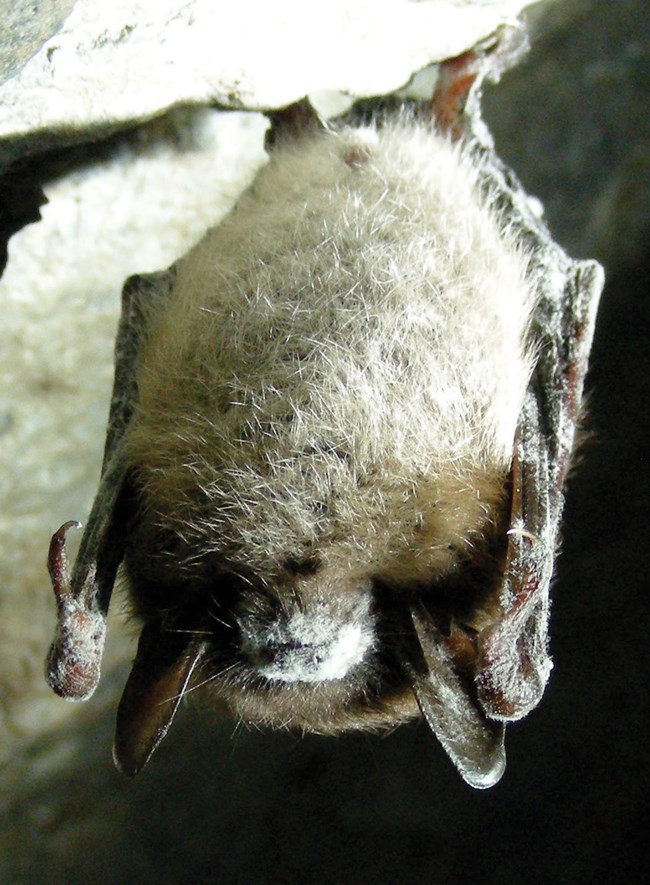Last updated: November 2, 2017
Article
Bat Projects in Parks: Grand Teton National Park
Bats, people, and properties: conservation and conflict in Grand Teton
PI: Dave Gustine, Shan Burson
Grand Teton (GRTE) began a multi-year study to assess bat populations to document species distribution and relative abundance as well as document presence and phenology of diurnal and nocturnal activity throughout the summer. We did this through acoustic detection of echolocation calls using Wildlife Acoustic's SM2BT FS, SM3BAT FS, and SM4BAT FS detectors at 37 sites. Preliminary analyses using Sonobat 4 with the Pacific West classifier indicate six species of bats (Little Brown, Big Brown, Hoary, Silver-haired, Long-legged, and Long-eared) were widespread and common, although at different relative proportions depending on location. Four additional species were tentatively ID'ed but at much lower abundance. We inventoried park infrastructure to catalog potential and existing bat roosts, and cataloged night lighting to assess association with bat activity. Next summer through a CESU agreement, we plan to capture bats to confirm species ID and to use radiotelemetry to locate summer roosts and hibernacula of little brown bats and other species. We developed two brochures to enhance WNS education and other bat-related information. The "Living with Bats" brochure was designed to provide an introduction to bats, their ecological benefits, the risks from rabies, and detailed information about WNS for visitors and park employees.

NPS Photo
Our Bat Community
Bats are amazing animals! They are the only flying mammal, can live 20 years and account for more than 1,000 different species. Bats are an essential part of the ecosystem – consuming insects and providing nutrients through their guano. Grand Teton National Park is home to ten species. The six most common species in the park are: little brown bats (Myotis lucifugus), big brown bats (Eptesicus fuscus), silver-haired bats (Lasionycteris noctivagans), hoary bats (Lasiurus cinereus), long-legged bats (Myotis volans) and long-eared bats (Myotis evotus). Research is underway to learn more about these bat communities, the risks facing them and human-bat interactions.
Bat Benefits
Bats are nocturnal, emerging from their day roosts at dusk to forage. To see them in action, look for bats in areas with plenty of insects or near trees and old buildings where bats rest at the night! Bats can consume over half their body weight in insects each night! They are the primary predators of night-flying insects. A recent study concluded that losing our bat populations could result in millions of dollars in increased pesticide costs and agricultural damage each year.
White-nose Syndrome (WNS)
First discovered in 2007, the disease known as
“white-nose syndrome” (WNS) appears as a white fuzzy growth on the nose, ears and wings of infected bats. Scientists identified a new species of fungus, Pseudogymnoascus destructans, as the cause. The fungus thrives in cool temperatures
(40–50° F) and high humidity —conditions often found in caves and mines where bats often roost and hibernate.
The fungus grows on hairless body parts during hibernation causing skin irritation. Infected bats may leave their hibernacula—hibernation roost—to forage for insects in freezing temperatures even though few insects are present. This activity may lead to death from dehydration or starvation, or cause bats to use fat reserves needed for survival. Some infected populations have experienced nearly 100 percent mortality within a few months. If you find a bat, never handle it!
Scientists are studying WNS to discover how the fungus is killing bats, what we can do to fight the syndrome, and how to protect the surviving bats.
White-nose Syndrome in Grand Teton
White-nose syndrome (WNS) is not found in Grand Teton National Park or elsewhere in Wyoming. WNS is spreading across the Midwest and was recently found in Washington State—highlighting the potential risk to this area. Bats and people exploring mines and caves can transmit WNS causing the fungus to spread. Explorers are encouraged to avoid caves in areas affected by WNS and follow decontamination protocols.
The Future of WNS
Scientists will continue studying the fungus that causes WNS. Actions to slow the spread of WNS include decontaminating equipment and people encountering bats and entering places that may harbor Pseudogymnoascus destructans. Caves known to harbor the fungus may be closed to public access. There are currently no methods to treat bats or hibernacula exposed to the fungus. Some positive news—a few bat populations affected by WNS appear to be naturally recovering from large-scale population declines.Other Threats
White-nose syndrome is not the only threat to bats. Habitat loss, windmills, pesticides and urbanization also threaten bat populations around the world.Living with Bats
Rabies
Less than one percent of bats have rabies. Humans contract rabies through saliva in a bite or scratch. Other common animals can carry rabies including raccoons, skunks, foxes, coyotes and feral cats. All animals with rabies die from the disease. Rabies is fatal in humans if not treated. Seek medical care immediately following exposure.Follow these tips to avoid exposure to rabies:
- Watch wildlife from a safe distance.
- Tell a ranger if you see an animal acting strangely.
- Vaccinate your pets.
- Educate childen about rabies - they are the most at risk!
Take Action!
If you have contact or may have had contact with a bat, you need to take action to prevent rabies.Seek medical attention if:
- A bat bites or scratches you.
- A bat lands on you.
- You wake up with a bat in your room.
The 4Cs of Rabies Prevention
- COLLECT the bat. If it can be done safely, to test the bat for rabies. Wear gloves and a long-sleeved shirt. Trap the bat in a container. Chill, but do not freeze the bat.
- CLEAN the contacted area of skin with soap and water, even if you do not see a wound.
- CONSULT a healthcare provider. Remember - rabies is preventable with proper medical care.
- CONTACT park dispatch and a NPS epidemiologist: Dr. Danielle Buttkee (970-631-5084) or Park Dispatch (307-739-3301)
Mapping the Spread of WNS

NPS map
